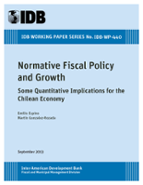Normative Fiscal Policy and Growth: Some Quantitative Implications for the Chilean Economy
Date
Sep 2013
This paper explores the qualitative and quantitative implications of optimal taxation in a developing economy when economic growth is endogenously determined. We differentiate this class of economies from a developed economy in two aspects: informal sector is quantitatively significant and tax-collecting technologies are more rudimentary. We characterize competitive equilibrium allocations and Ramsey allocations in the context of a small open economy in which the interest rate is endogenously determined, some workers can be hired in the informal market, and imperfect tax-collecting technology can be heterogeneous across different types of taxes. We calibrate the parameters of our model to the Chilean economy. Overall, our results suggest that capital should still be taxed but considerably less than actual taxes (that is, 10.78 percent versus 18.5 percent). Labor should be subsidized (to stimulate accumulation of human capital), while consumption taxes should be increased by 50 percent approximately (from 19 percent to 28 percent). As expected, the better the tax collecting technologies, the higher the corresponding taxes. In this context, the resulting growth rate increases only slightly along the balanced growth path.




